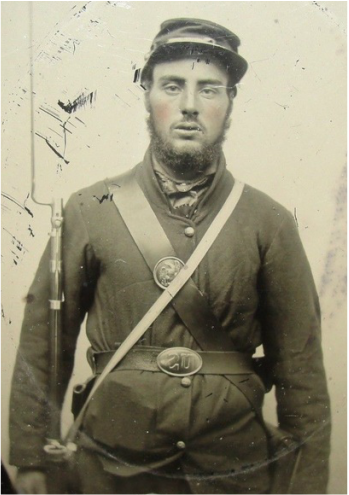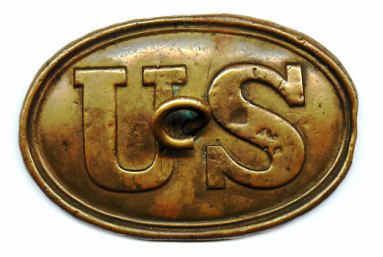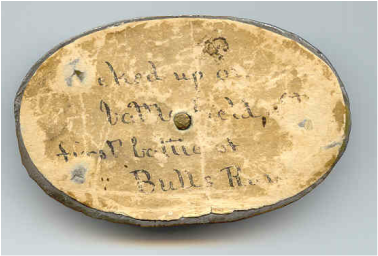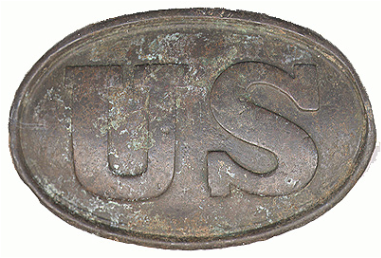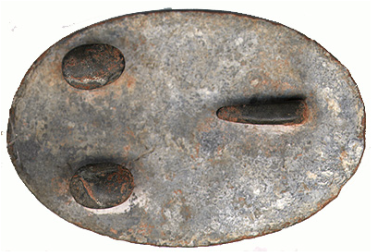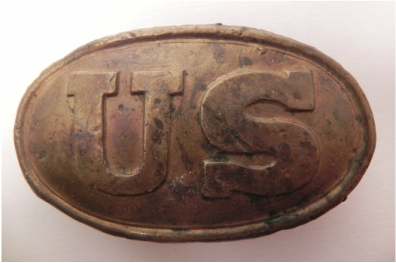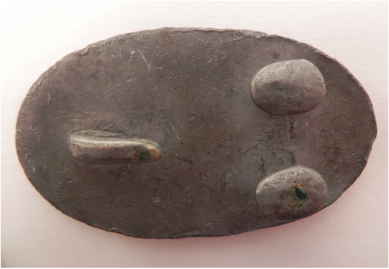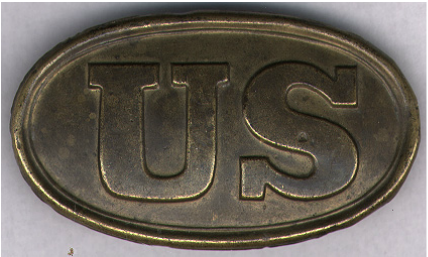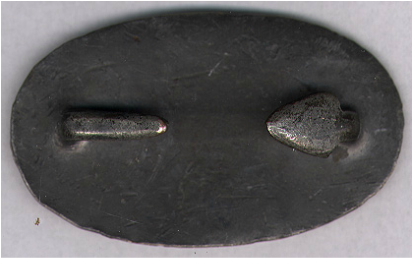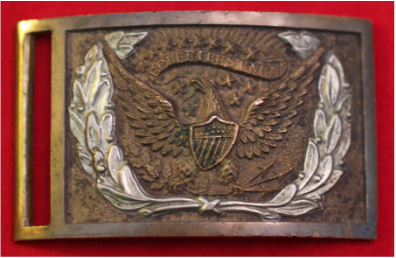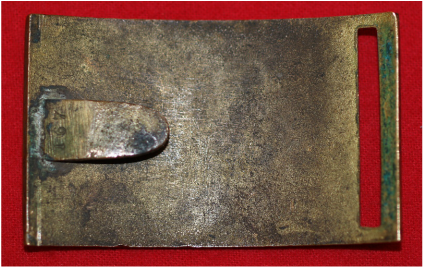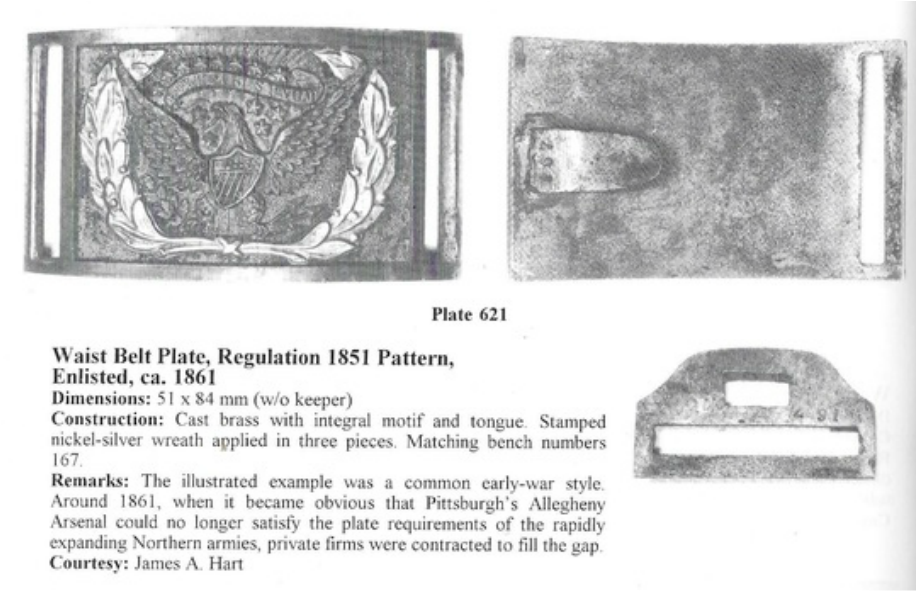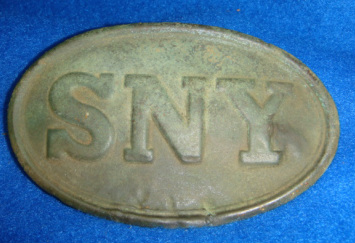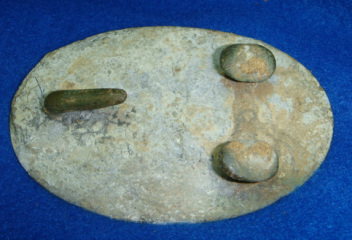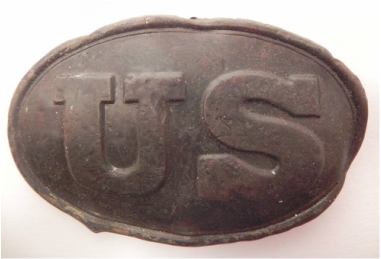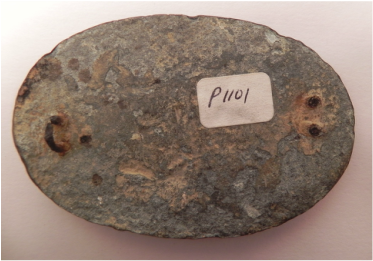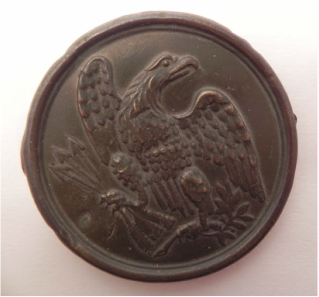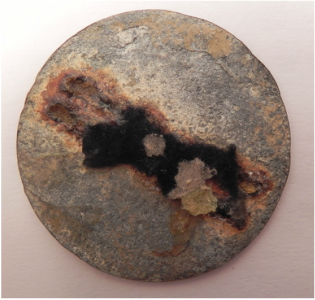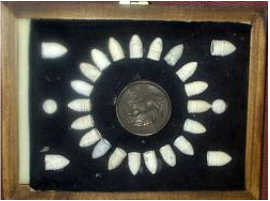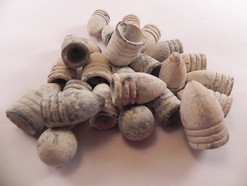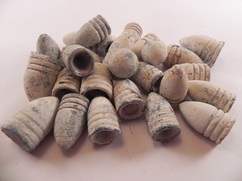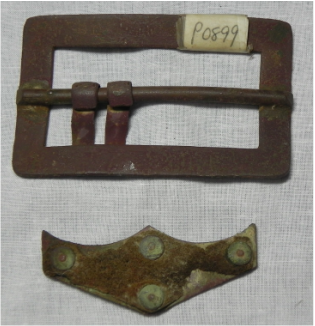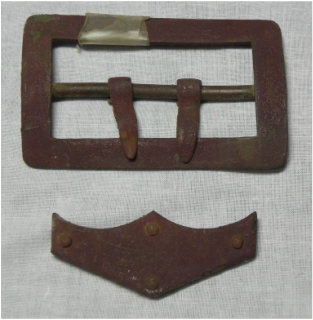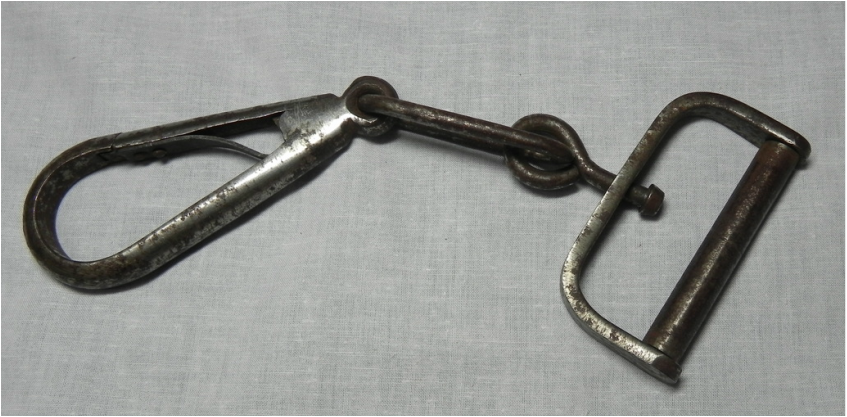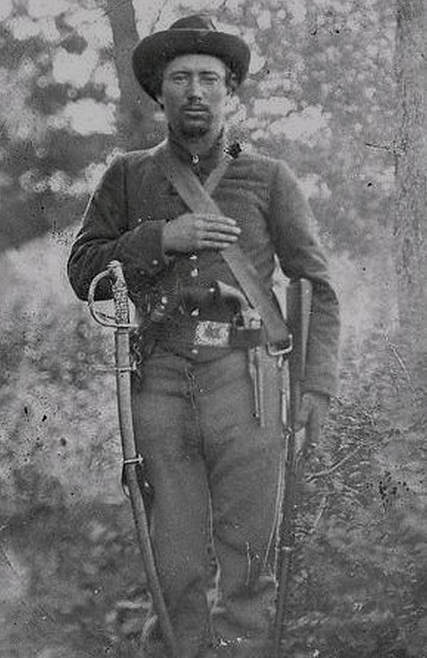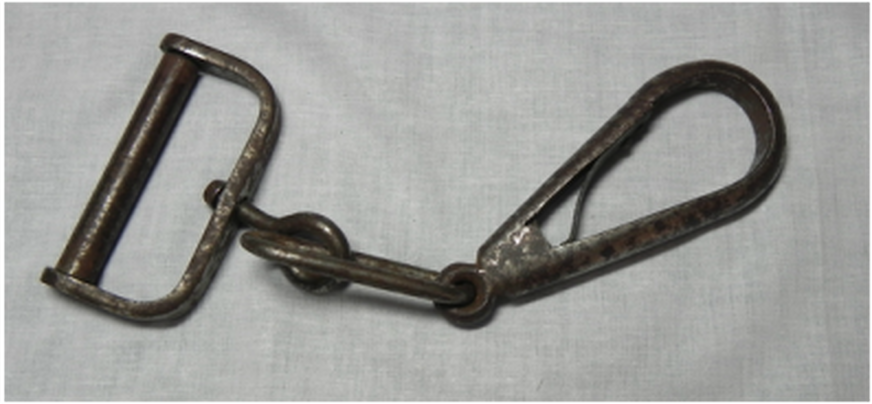U.S. BUCKLES AND PLATES
MODEL 1839 WAIST BELT PLATE DUG ANTIETAM CREEK
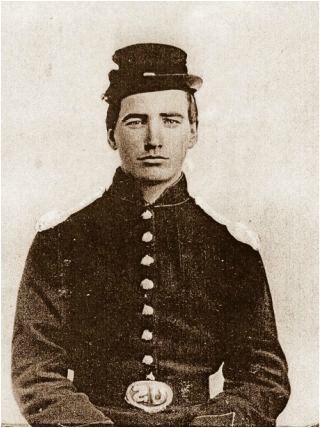
This is a U.S. plate with an old tag glued on the back that reads "picked up on battlefield, first battle of Bull Run".
"On July 21, 1861, Union and Confederate armies clashed near Manassas Junction, Virginia, in the first major land battle of the American Civil War. Known as the First Battle of Bull Run (or Manassas), the engagement began when about 35,000 Union troops marched from the federal capital in Washington, D.C. to strike a Confederate force of 20,000 along a small river known as Bull Run. After fighting on the defensive for most of the day, the rebels rallied and were able to break the Union right flank, sending the Federals into a chaotic retreat towards Washington. The Confederate victory gave the South a surge of confidence and shocked many in the North, who realized the war would not be won as easily as they had hoped."
This item is from a very old collection. Clearly the hooks on the back where cut off in order to display the plate better which is unfortunate but not uncommon in the early days of collecting, The brass loop embedded in the center of the plate was a mystery to me for many years until an old time collector offered an explanation. He suggests that someone used the loop to hang the buckle in order to display it on a wall. "Back then" the buckle had very little value other than the history so they put the loop on the face and hung it on a display board so you could read the history on the back. As stated, this is the way many buckles were displayed at one time. The buckle measures about 53 mm x 85 mm, has a very nice patina and all the bumps and scrapes one would expect. This item was purchased many years ago from Horse Soldier and came from a large Gettysburg/Antietam collection from Maryland. You seldom see buckles with such solid graphic battlefield history as this.
(Reference; "American Military Belt Buckle" by Michael J. O'Connell and J. Duncan Campbell, plate 505, "Plates and Buckles of the American Military 1795-1874" by Sydney C. Kerksis, page 26; "Accoutrement Plates North and South 1861-1865" by William G. Gavin, page 15; "Excavated Artifacts from Battlefields and Campsites of the Civil War 1861-1865" by Stanley S. Phillips, page 5)
"On July 21, 1861, Union and Confederate armies clashed near Manassas Junction, Virginia, in the first major land battle of the American Civil War. Known as the First Battle of Bull Run (or Manassas), the engagement began when about 35,000 Union troops marched from the federal capital in Washington, D.C. to strike a Confederate force of 20,000 along a small river known as Bull Run. After fighting on the defensive for most of the day, the rebels rallied and were able to break the Union right flank, sending the Federals into a chaotic retreat towards Washington. The Confederate victory gave the South a surge of confidence and shocked many in the North, who realized the war would not be won as easily as they had hoped."
This item is from a very old collection. Clearly the hooks on the back where cut off in order to display the plate better which is unfortunate but not uncommon in the early days of collecting, The brass loop embedded in the center of the plate was a mystery to me for many years until an old time collector offered an explanation. He suggests that someone used the loop to hang the buckle in order to display it on a wall. "Back then" the buckle had very little value other than the history so they put the loop on the face and hung it on a display board so you could read the history on the back. As stated, this is the way many buckles were displayed at one time. The buckle measures about 53 mm x 85 mm, has a very nice patina and all the bumps and scrapes one would expect. This item was purchased many years ago from Horse Soldier and came from a large Gettysburg/Antietam collection from Maryland. You seldom see buckles with such solid graphic battlefield history as this.
(Reference; "American Military Belt Buckle" by Michael J. O'Connell and J. Duncan Campbell, plate 505, "Plates and Buckles of the American Military 1795-1874" by Sydney C. Kerksis, page 26; "Accoutrement Plates North and South 1861-1865" by William G. Gavin, page 15; "Excavated Artifacts from Battlefields and Campsites of the Civil War 1861-1865" by Stanley S. Phillips, page 5)
MODEL 1839 FEDERAL INFANTRY WAIST BELT PLATE
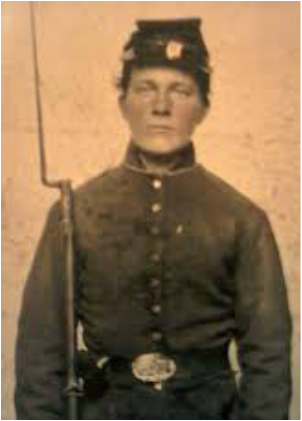
This federal infantry waist belt plate is of the early regulation 1839 pattern with the puppy paws. The plate measures about 54 mm x 84 mm. This relic was recovered at the battle area at Bald knob, Kennesaw Mountain, Georgia in December 1953.
"On the night of June 18-19, Gen. Joseph E. Johnston, fearing envelopment, withdrew his army to a new, previously selected position astride Kennesaw Mountain. This entrenched arc-shaped line, to the north and west of Marietta, protected the Western & Atlantic Railroad, the supply link to Atlanta. Having defeated General John B. Hood troops at Kolb’s Farm on the 22nd, Sherman was sure that Johnston had stretched his line too thin and, therefore, decided on a frontal attack with some diversions on the flanks. On the morning of June 27, Sherman sent his troops forward after an artillery bombardment. At first, they made some headway overrunning Confederate pickets south of the Burnt Hickory Road, but attacking an enemy that was dug in was futile. The fighting ended by noon, and Sherman suffered high casualties."
This die-stuck specimen has the large raised letters "US" on the face and exhibits a wonderful dark bronze patina overall. The backside of the plate, complete with its brass puppy paw hooks all intact, is lead filled and still in strong condition with just a hint of surface erosion to the lead. The face of the convex plate is edged with double borders with one tiny edge nick.
(Reference; "American Military Belt Buckle" by Michael J. O'Connell and J. Duncan Campbell, plate 508;"Plates and Buckles of the American Military 1795-1874" by Sydney C. Kerksis, page 34; "Accoutrement Plates North and South 1861-1865" by William G. Gavin, page 15)
RARE MEDIUM SIZED U.S. PLATE
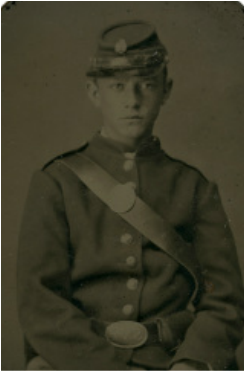
This is a rare version of the Civil War U.S. belt buckle that you seldom see. It is the style referred to by collectors as the "Medium" size buckle. It has the overall measurements of 46.4 mm x 78.4 mm which puts it between the small and large size belt buckles. These plates were probably purchased in the early days of the war for use with state militias. The face of the plate has a nice and clear U.S. with a nice patina. The reverse of the plate has the stud style hooks intact with excellent original lead remaining.
(Reference; "American Military Belt Buckle" by Michael J. O'Connell and J. Duncan Campbell, plate 516; "Accoutrement Plates North and South 1861-1865" by William G. Gavin, page 16)
SMALL SIZED U.S. PLATE
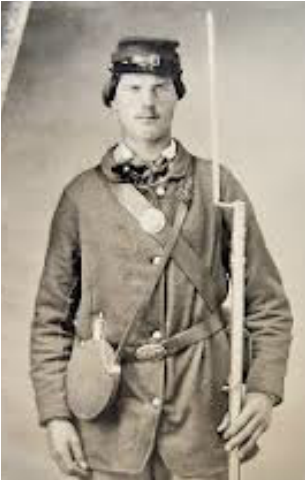
U.S. Regulation 1839 Pattern small oval waist belt plate. It is die-struck with the rolled brass and lead filled with brass arrow hook. The buckle has a lightly polished semi dull finish and normal scratches and dings from wear. It has what appears to be a stamping flaw on the S. The size of the buckle is 71 mm x 41 mm and is often referred to as the "baby" U.S. plate because of its size. They are about 2/3 the size of the standard Civil War U.S. belt buckle. There were far fewer of these small size buckles made compared to its larger counterpart. This plate is in nice shape with great patina.
(Reference; "American Military Belt Buckle" by Michael J. O'Connell and J. Duncan Campbell, plate 526; "Plates and Buckles of the American Military 1795-1874" by Sydney C. Kerksis, page 21; "Accoutrement Plates North and South 1861-1865" by William G. Gavin, page 8; "Civil War Artifacts A Guide to The Historian" by Howard Crouch, page 187; "Civil War Collector's Encyclopedia", Volume IV, by Francis A. Lord, , page 6; "Excavated Artifacts from Battlefields and Campsites of the Civil War 1861-1865" by Stanley S. Phillips, page 5)
LARGE MEDIUM AND SMALL US BUCKLES
REGULATION 1851 PATTERN N.C.O. WAIST BELT PLATE
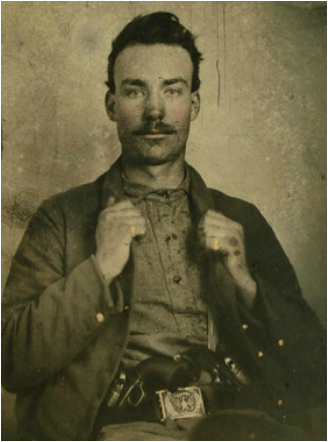
Early-war style regulation 1851 pattern Federal sword belt plate. It depicts the patriotic eagle and was used by officers and enlisted cavalry. The plate was made of cast brass, the eagle is integral to the casting and wreath is applied. Plate measures 50.9 mm x 84.5 mm. It is stamped "167" and has a dull brass untouched finish. Reverse has the green verdigris coloring. Companion keeper benchmark is stamped "400" and makes a nice fit over the tongue but obviously a replacement. This is the exact plate shown in the American Military Belt Plates by Michael J. O'Donnell & J. Duncan Campell. It is plate "621" on page 378. When the book was published the keeper accompanying the plate was stamped 491. That keeper has been separated from the plate and replaced by the current keeper which matches nicely but is not original to the plate. In the days of issuance and in the earlier days of collecting there was little concern for matching numbers. Still, a very nice, published artifact from the James A. Hart collection.
Reference: "American Military Belt Buckle" by Michael J. O'Connell and J. Duncan Campbell, plate 621;"Plates and Buckles of the American Military 1795-1874" by Sydney C. Kerksis, page 63; "Accoutrement Plates North and South 1861-1865" by William G. Gavin, page 18)
WATCH OUT FOR FAKES AND REPOS
This is a Hanover Brass reproduction of my original plate. GW is stamped on the repos but is often filed off and plate is sold as original. Wreath tips are what to look for. They do not reproduce the original wreath tips above the wings. Reproduction tips are different. Reproduction hook is different (see images)' Also the hook is soldered to the plate and the original was brazed which makes it look like it is cast solid on the original. You can see a silver solder line on all the Hanover hooks at the base where the hook meets the plate.
STATE OF NEW YORK WAIST BELT PLATE
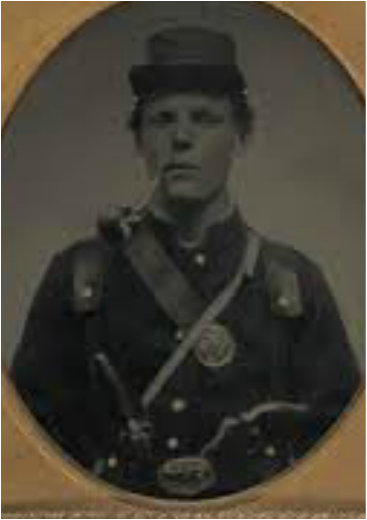
The belt plate depicts the broad letter style "SNY", intended for troops of the State of New York. It has the oval shape following the Federal Regulation of 1839. This style is somewhat scarce and apparently cartridge box plates were made in equal quantities.This plate has a beautiful greenish brown patina. The back has good lead with just enough wear to show lots of use. This has the early "puppy paw" style studs. The face has nice eye appeal and only one tiny ding from the digger which has been repaired. Measures about 55 mm x 88 mm.
(Reference: "American Military Belt Buckle" by Michael J. O'Connell and J. Duncan Campbell, plate 546;"Plates and Buckles of the American Military 1795-1874" by Sydney C. Kerksis, page 130; "The Illustrated History of American Civil War Relics" by Stephen W. Sylvia & J. O'Donnell, page 206, 287; "Accoutrement Plates North and South 1861-1865" by William G. Gavin, page 28; "Civil War Artifacts A Guide to The Historian" by Howard Crouch, page 193; "Excavated Artifacts from Battlefields and Campsites of the Civil War 1861-1865" by Stanley S. Phillips, page 12)
U.S. CARTRIDGE BOX PLATE
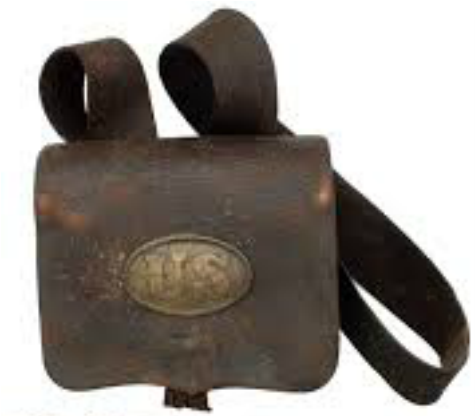
This is a Regulation 1839 U.S. Oval cartridge box plate and would be from Contractor Boyd & Sons noted for the rounded "U" and fat "S". This dug plate has some bends and dings but still has one hook in tact. Measures about 87 mm x 57 mm. It was recovered at Averasborough, North Carolina.
"On the afternoon of March 15, 1865 Judson Kilpatrick’s cavalry came up against Lt. Gen. William Hardee’s corps—consisting of Taliaferro’s and McLaw’s infantry divisions and Wheeler’s dismounted cavalry—deployed across the Raleigh Road near Smithville. After feeling out the Confederate defenses, Kilpatrick withdrew and called for infantry support. During the night, four divisions of the XX Corps arrived to confront the Confederates. At dawn, March 16, the Federals advanced on a division front, driving back skirmishers, but they were stopped by the main Confederate line and a counterattack . Mid-morning, the Federals renewed their advance with strong reinforcements and drove the Confederates from two lines of works, but were repulsed at a third line. Late afternoon, the Union XIV Corps began to arrive on the field but was unable to deploy before dark due to the swampy ground. Hardee retreated during the night after holding up the Union advance for nearly two days."
Most equipment was meant to serve a purpose and the cartridge box plate helped keep the flap down whereas the beast plate made a good target for the Confederate rifleman and were often discarded.
(Reference; "American Military Belt Buckles" by Michael J. O'Connell and J. Duncan Campbell, plate 486; "Plates and Buckles of the American Military 1795-1874" by Sydney C. Kerksis, page 42)
U.S. BREASTPLATE & DROPPED BULLETS
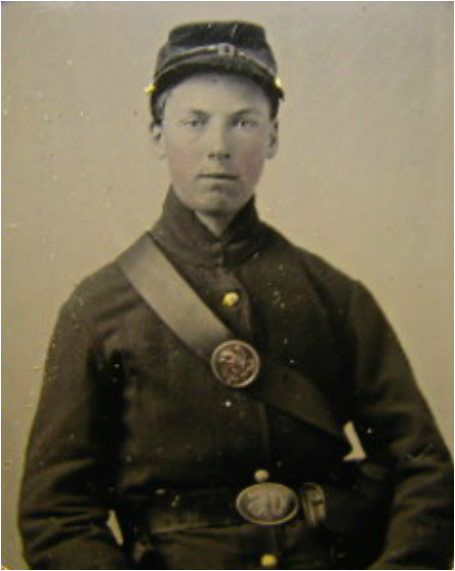
Breastplate depicts a patriotic eagle, and was used by the Federal army as well as the states. The shoulder plate is round following the Federal Regulation of 1826 and was used as ornamentation on the shoulder strap. Many were used as targets for the enemy and were often discarded. This is a common wartime style associated with W.H. Smith of Brooklyn, New York. The plate is stamped on thin sheet brass, solder filled and configured as an enlisted shoulder plate. The two iron loops are rusted or cut away on this one and there are remnants of glue on the back where it was originally attached for the display shown above. Plate measures 64 mm, approx. Nice relic which was dug along with 22 dropped bullets. This was purchased from Lawrence Christopher of Dalton, Georgia and he states the plate and bullets were dug on the battlefield at Perryville, Kentucky and he purchased this directly from the digger.
"In the summer of 1862, Confederate Gen. Braxton Bragg launched an invasion of the key border state of Kentucky, hoping to divert Union attention from the Southern strongholds at Vicksburg and Chattanooga, as well as to encourage Bluegrass State volunteers to join the Rebel army. Though unsuccessful in the last regard, the Kentucky Campaign did draw Federal forces out of northern Alabama and Middle Tennessee, ground it would take the Union almost a year to regain. The largest engagement fought in Kentucky, the Battle of Perryville was a Confederate tactical victory, though the heavy fighting and bloodshed forced Bragg to retreat into Tennessee. During the battle, the Confederates held an early advantage that they were able to exploit due to lack of communication among various elements of the Union force. Eventually reinforced on the left of their line, the Federal troops held their ground and pushed some of their attackers back into the town of Perryville itself. Confronted by a larger force and running low on supplies, Bragg withdrew toward the Cumberland Gap. His army would never return to Kentucky."
(Reference; American Military Belt Buckle, Michael J. O'Connell and J. Duncan Campbell, plate 466; "Accoutrement Plates North and South 1861-1865" by William G. Gavin, page 4; "Excavated Artifacts from Battlefields and Campsites of the Civil War 1861-1865" by Stanley S. Phillips, page 7)
"In the summer of 1862, Confederate Gen. Braxton Bragg launched an invasion of the key border state of Kentucky, hoping to divert Union attention from the Southern strongholds at Vicksburg and Chattanooga, as well as to encourage Bluegrass State volunteers to join the Rebel army. Though unsuccessful in the last regard, the Kentucky Campaign did draw Federal forces out of northern Alabama and Middle Tennessee, ground it would take the Union almost a year to regain. The largest engagement fought in Kentucky, the Battle of Perryville was a Confederate tactical victory, though the heavy fighting and bloodshed forced Bragg to retreat into Tennessee. During the battle, the Confederates held an early advantage that they were able to exploit due to lack of communication among various elements of the Union force. Eventually reinforced on the left of their line, the Federal troops held their ground and pushed some of their attackers back into the town of Perryville itself. Confronted by a larger force and running low on supplies, Bragg withdrew toward the Cumberland Gap. His army would never return to Kentucky."
(Reference; American Military Belt Buckle, Michael J. O'Connell and J. Duncan Campbell, plate 466; "Accoutrement Plates North and South 1861-1865" by William G. Gavin, page 4; "Excavated Artifacts from Battlefields and Campsites of the Civil War 1861-1865" by Stanley S. Phillips, page 7)
U.S. CARBINE SLING BUCKLE
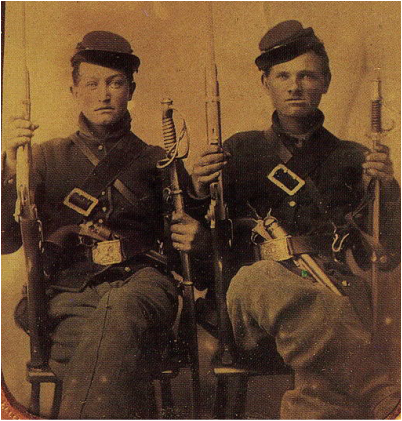
Regulation 1841 U.S. Cavalry carbine sling buckle. This plain buckle was used to fasten a shoulder sling, from which the cavalryman could hang his carbine when riding. Construction is simple cast brass with a bar brazed to the frame. Flippers were cast and then bent into place. A cast brass end plate was fastened to the strap with rivets intended to give rigidity to the end of the wide leather belt; sometimes called a "batwing" by modern collectors. Size and thickness varies; some are small contractor or Confederate copies. This one is marked "US". The contractor would have been E. Gaylord and T. Shepard was the inspector at the Springfield Mass. arsenal which supervised the contract. This item was recovered from Summit Point, Va.
"As Maj. Gen. Philip Sheridan concentrated his army near Charles Town, Lt. Gen. Jubal Early and Maj. Gen. Richard Anderson attacked the Federals with converging columns on August 21, 1864. Early moved east via Smithfield against the Union VI Corps. Anderson struck north against Wilson's Union cavalry at Summit Point. There was cavalry fighting near Berryville. The Federals fought effective delaying actions, withdrawing to near Halltown on the following day."
(Reference; "American Military Belt Buckle" by Michael J. O'Connell and J. Duncan Campbell, plate 799; "Civil War Artifacts A Guide to The Historian" by Howard Crouch, page 193; "Civil War Relics of the Western Campaigns" by Charles S. Harris, page 101; "Civil War Collector's Encyclopedia", Volume IV, by Francis A. Lord, page 141; "Excavated Artifacts from Battlefields and Campsites of the Civil War 1861-1865" by Stanley S. Phillips, page 22 ).
Regulation 1841 U.S. Cavalry carbine sling buckle. This plain buckle was used to fasten a shoulder sling, from which the cavalryman could hang his carbine when riding. Construction is simple cast brass with a bar brazed to the frame. Flippers were cast and then bent into place. A cast brass end plate was fastened to the strap with rivets intended to give rigidity to the end of the wide leather belt; sometimes called a "batwing" by modern collectors. Size and thickness varies; some are small contractor or Confederate copies. This one is marked "US". The contractor would have been E. Gaylord and T. Shepard was the inspector at the Springfield Mass. arsenal which supervised the contract. This item was recovered from Summit Point, Va.
"As Maj. Gen. Philip Sheridan concentrated his army near Charles Town, Lt. Gen. Jubal Early and Maj. Gen. Richard Anderson attacked the Federals with converging columns on August 21, 1864. Early moved east via Smithfield against the Union VI Corps. Anderson struck north against Wilson's Union cavalry at Summit Point. There was cavalry fighting near Berryville. The Federals fought effective delaying actions, withdrawing to near Halltown on the following day."
(Reference; "American Military Belt Buckle" by Michael J. O'Connell and J. Duncan Campbell, plate 799; "Civil War Artifacts A Guide to The Historian" by Howard Crouch, page 193; "Civil War Relics of the Western Campaigns" by Charles S. Harris, page 101; "Civil War Collector's Encyclopedia", Volume IV, by Francis A. Lord, page 141; "Excavated Artifacts from Battlefields and Campsites of the Civil War 1861-1865" by Stanley S. Phillips, page 22 ).
CARBINE SLING SWIVEL
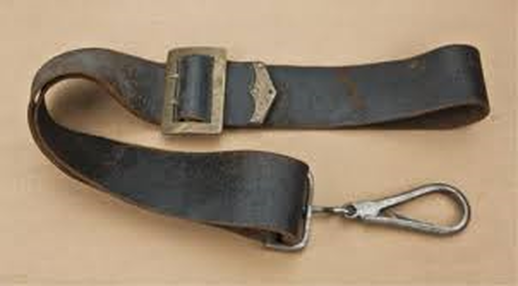
This item is a heavy iron hook attached to an iron keeper. The hook has a snap-gate on one side. This allows the hook to attach to the iron “O” ring on the carbine saddle bar. This bar is located on a carbine on the side opposite from the lock. The keeper above the hook has a roller attached to the top. A leather sling slides through this keeper and the sling is then placed over the Cavalryman’s shoulder. When a trooper is mounted the hook and roller and sling allow the carbine to be raised, fired and released again without losing possession of the weapon. This specimen is in good condition with moderate surface dirt and some discoloration. Both the snap-gate and the roller work well. Carbine sling swivel has the New Haven's Manufacturer's stamp. This keeper along with the sling buckle above completes the hardware for the Cavalryman's sling.
(Reference: "Civil War Collector's Encyclopedia", Volume IV, by Francis A. Lord, page 141; "Gettysburg Battlefield Relics and Souvenirs" by Mike O'Donnell, pages 248, 252; Civil War Relics of the Western Campaigns by Charles S. Harris. pages 101,176, 153, 198)
